
How to Earn Loyalty & Make a Difference with Cause Marketing
There’s a lot of noise in the ecommerce world.
With so many brands saying the same things and offering the same deals, it can be tough for marketing efforts to actually turn the heads of the people you want to reach.
You need to say something different to make an impact.
Embracing cause marketing gives you the unique opportunity to stand out, to build customer loyalty, and to give back all at the same time.
Here’s how you can put it to good use.
What is Cause Marketing?
First: What is cause marketing?
Cause marketing happens when a for-profit company teams up with a not-for-profit organization (or cause) to provide marketing exposure that both drives sales and donations — a win-win!
This marketing approach gives businesses an opportunity to have a visible, memorable impact on a charity that it cares about deeply. At the same time, it builds recognition and trust with customers who value companies willing to share their profits with a good cause.
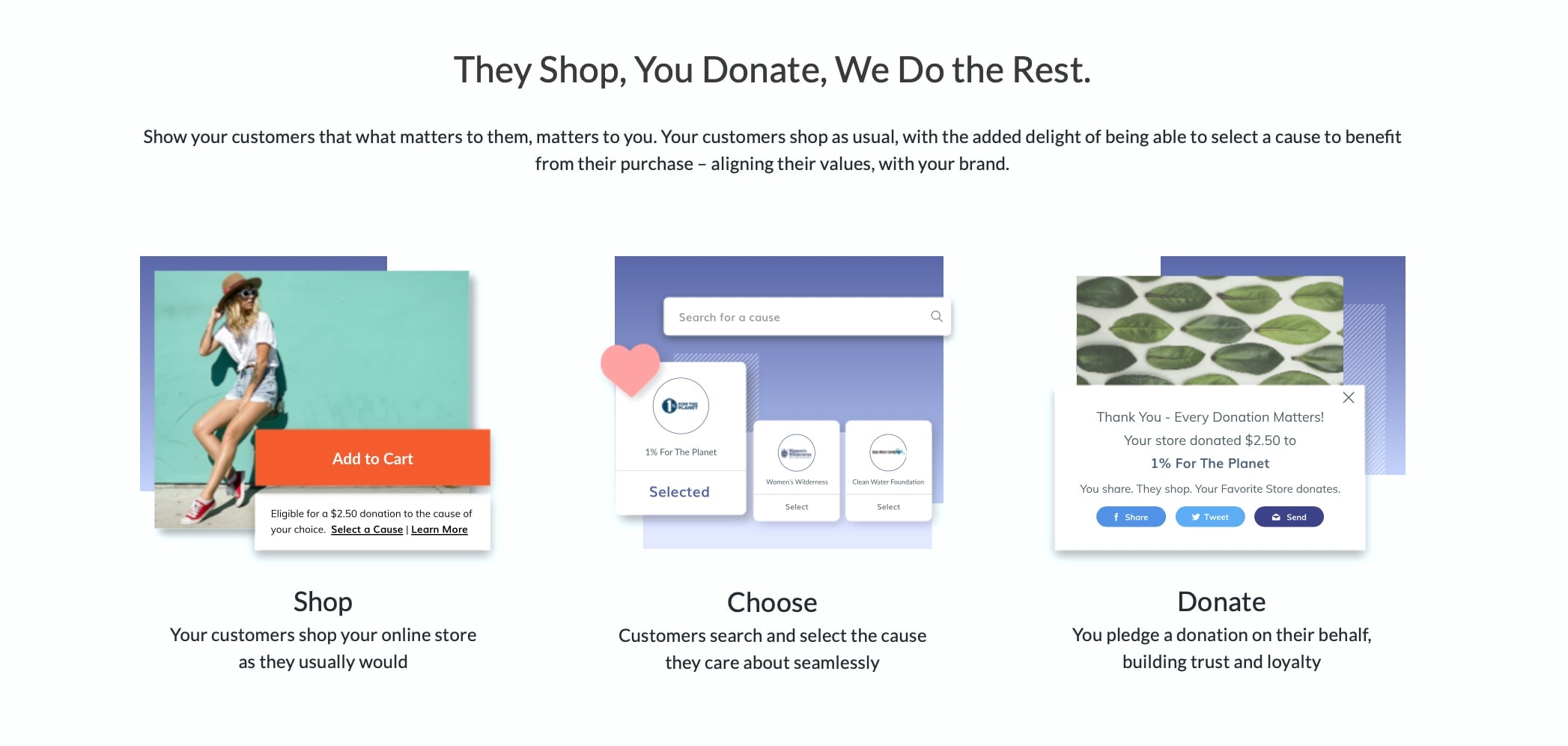
(Source)
Cause Marketing & Corporate Social Responsibility
The cause marketing strategy fits well with a company’s corporate social responsibility (CSR) efforts. CSR represents a shifting company culture — a new ethos that’s focused on making the world a better place. As your organization works toward this goal, it holds itself accountable for how it impacts both the environment and people’s lives.
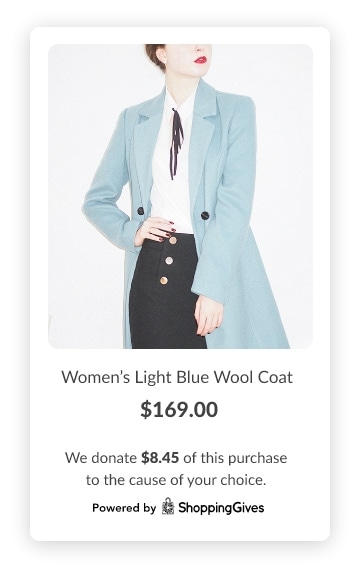
Companies use many different strategies when they adopt a CSR, such as:
- Retrofitting buildings to be more energy efficient
- Committing to carbon neutrality by reducing emissions and purchasing renewable energy credits
- Creating systems to ethically and transparently source raw materials
- Changing their HR policies to improve their employees’ standard of living
- Making charitable donations to organizations that share their values
Cause marketing empowers everyone in your organization — from the CEO all the way to the customer — to get involved in the company’s charitable giving efforts.
How Does Cause Marketing Work?
The cause marketing recipe is simple: You choose a brand-relevant cause that you care about, create a marketing campaign around it, and donate some of your profits and resources from the campaign to it. Today, there are even tools like ShoppingGives that integrate seamlessly with your ecommerce store to make this ultra-simple.
The more your customers engage with the campaign, the larger your impact will be. You can either dedicate a specific product or product line to the campaign, create a new product specifically for it, or expand it to include all of your sales.
The latter is what Anatomie, a Miami-based women’s athleisure brand, does. Each month, the brand partners with a new organization. For every sale they make, they donate 1% of the purchase price to that month’s charity.
Every cause Anatomie chooses is relevant to its audience and fits its mission to empower and inspire. They’ve already partnered with causes like No Kid Hungry, Breast Cancer Awareness Month, Feeding America, and more.
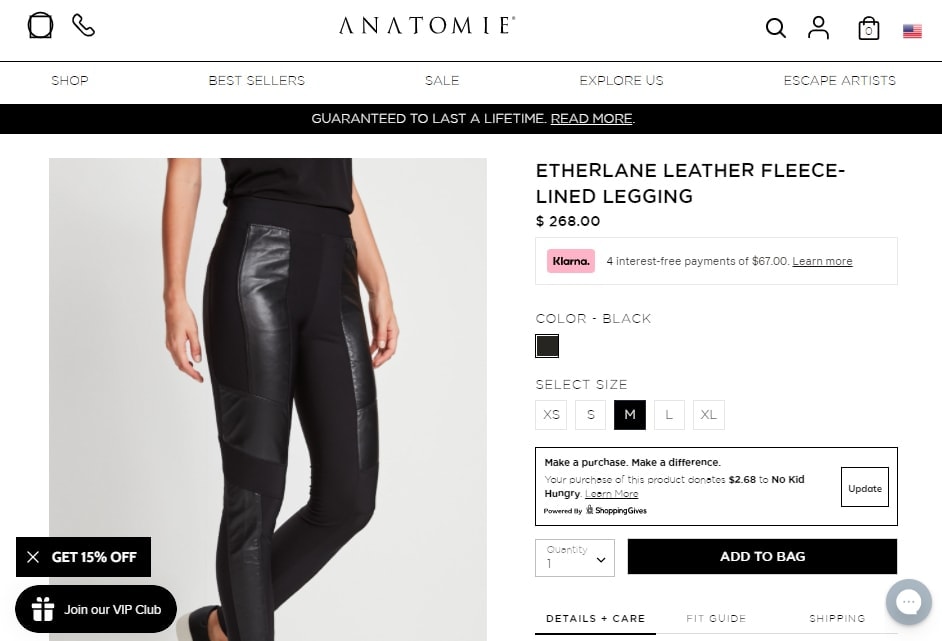
Younger Generations Support Brands Who Give
Cause marketing not only raises funds and increases awareness for your partner charities, but it also builds loyalty and affection for your brand — especially from Millennials and Gen Z.
Each generation is raising its expectations for companies to make a positive social impact, with 81% of Millennials expecting brands to support social causes and charities.

(Source)
Fortunately, these younger generations are willing to put their money where their mouths are.
A 2019 study from the Center for Generational Kinetics discovered that only 23% of Baby Boomers would be more likely to buy from a company that contributes to causes that they agree with, compared to 69% of Gen Z.
Millennials and Gen Z are constantly consuming new content online. From entertainment to advertising, something is always vying for their attention, making it difficult for you to stand out among all that noise.
Cause marketing can give you an edge and help you make a positive, lasting impression on people who are searching for brands that are helping more than their own bottom line.
Why Now is a Great Time to Start a Cause Marketing Campaign
Cause marketing puts you a leg up in the race for loyal customers — and it’s becoming more popular every year. As consumers expect brands to do more to benefit society, cause marketing can put your efforts front and center by attracting more loyal customers and drawing attention to causes that you care about.
With corporate giving up 15% over the last two years, many companies are embracing charity as their industries adapt to what their customers want. If you can grab people’s attention now, you can reap the benefits of better customer loyalty for years.
So how does cause marketing help build customer loyalty? It builds trust.
Zeno’s 2020 Strength of Purpose study found that consumers are 4.1x more likely to trust a company that they perceive to have a strong purpose.
And once you earn your customers’ trust, they’ll continue to support you as long as you don’t lose it, leading to big increases in revenue and higher lifetime customer values.
Compliance & Cause Marketing: How to Do It Right
Compliance is a big deal when you’re giving back. It protects not only your company but also the causes and charities you donate to. The last thing you want is to run into legal hurdles that could take away from the good you’re accomplishing with a cause marketing campaign.
Before you launch, make sure you’re prepared with these four must-haves to keep your campaign organized and compliant.
#1: Commercial Co-Venture Agreement (CCV)
A co-venture is any time a for-profit business advertises or promotes a sale that benefits a charity — in other words, cause marketing. Several states require businesses to register as co-ventures and submit a commercial co-venture agreement (CCV).
This agreement outlines the details of your cause marketing partnership with the charity, including important details like:
- The name of the charity or cause
- The campaign dates
- The percentage of sales you’ll donate
- Your plan to disclose how much you donate at the end of the campaign
Specific rules for commercial co-ventures vary by state, so it’s best to check the regulations for each partnership. The National Council of Nonprofits is a good resource on state laws for charitable organizations.
#2: Transparency
While it may be fine to say “We’ll donate 10% of our sales” or “We’ll donate 3% of our profits” in your marketing materials, you have to be more explicit with customers when they checkout.
Standard 19 from the Better Business Bureau (BBB) says you need to disclose:
- The actual or anticipated donation amount from each sale
- How long the campaign lasts
- Any guaranteed maximum or minimum contributions
Making this disclosure at checkout protects the customer by showing them, before they complete a purchase, exactly how much of their purchase will go to charity.
#3: Intellectual Property Permissions
Nonprofits work hard and invest a lot of money to make sure their names are recognized and associated with certain missions and causes. Like your company, nonprofits want to protect their brand by enforcing trademarks and name use restrictions.
You need to respect that investment by working to protect the image of the charities you support. Don’t use their names or logos unless you have explicit permission to do so from the non-profit.
#4: Record-Keeping
For every cause marketing campaign you run, you need to keep detailed records. These records serve two purposes: Analyzing your marketing efforts and making sure you get the proper tax deductions from the campaign.
Your records should include five data points:
- The amount donated on a per-unit basis
- Any refunds or returns that result in a change in donation
- Receipts from your donations to the charity
- Your CCV contract
- The final results from the campaign
You’ll want to keep these records for at least seven years in case you need them for a financial audit.
The good news: A tool like ShoppingGives takes care of all of this for you.
Tips for Choosing a Cause Marketing Partner
If you’re going to launch a successful cause marketing campaign, you need to partner with the right charity. Choosing the wrong partnership could make your campaign self-destruct — harming both you and the charity you’re trying to support.
In 2010, KFC launched a cause marketing campaign called “Buckets for a Cure,” where it pledged $0.50 to Susan G. Komen — an organization working to end breast cancer forever — for every bucket of chicken they sold.
The campaign received a lot of backlash from people who found it hypocritical to support a health cause by buying unhealthy food. The mismatch strained the campaign and distracted from its efforts to raise money for medical research.
To avoid making the same mistake, you have to pick the right cause marketing partner for your company. You’ll find a lot of great causes and organizations out there, but not all of them will be a good fit.
There’s a four-part formula for great cause marketing partnerships, and it looks like this:
- Great Partner Causes Match Your Company Ethos: You need to value the same things and share either a common or complementary mission.
- Great Partner Causes Resonate with Your Customers: For a cause marketing campaign to succeed, your customers need to care enough about the cause to get excited about supporting it.
- Great Partner Causes Excite Your Company’s Leadership: If your company’s leaders are passionate about an organization, you’ll have more access to the time, resources, and influence you need for a great campaign.
- Great Partner Causes Engage Your Employees: Your staff are on the front lines talking to customers, fulfilling orders, and providing customer service. If the charity you support engages them, they’ll become your campaign’s top promoters.
How to Start a Cause Marketing Campaign on Your Shopify Store
You can easily launch your cause marketing campaign on your Shopify store with ShoppingGives, a social commerce platform that helps companies make charitable donations through their customers’ purchases.
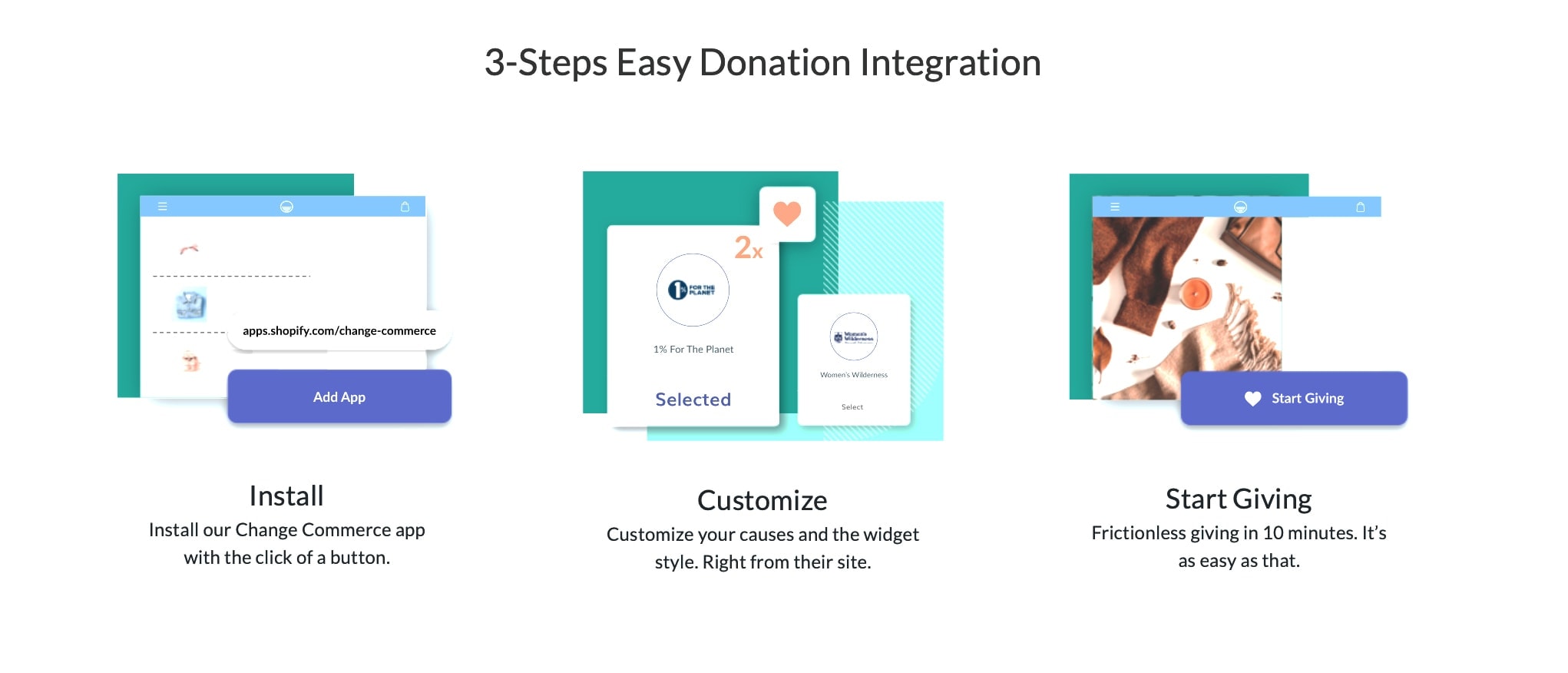
The platform gives your customers a seamless way to support causes at checkout and manages all of the reporting and donations for you. Best of all, it’s easy to connect to your Shopify store so you can start collecting donations for your favorite causes right away.
Here’s How to Get Started:
- Install the Change Commerce App by ShoppingGives: You’ll find the Change Commerce app in the Shopify App Store.
- Choose Your Cause (or Causes): ShoppingGives’ database has over one million registered 501(c)(3) nonprofits that you can support. You can select up to six feature causes or let your customers choose their own.
- Customize Your Customer Experience: You can customize the donation widget to match your own branding and fit seamlessly into your checkout sequence, giving your customers a great user experience.
- Start Giving: It takes less than 10 minutes to set up the widget, allowing you to start giving right away.
To show you how this looks in action, let’s next look at a few examples of brands that have used this tool to launch successful cause marketing campaigns.
4 Examples of Cause Marketing Done Right
Kenneth Cole Crafts Cause Marketing into its DNA
Supporting public health and civil liberties is baked into Kenneth Cole’s DNA. For over 35 years, the shoe brand has supported AIDS research, fought homelessness, and supported civic engagement in its advertising and charitable giving.
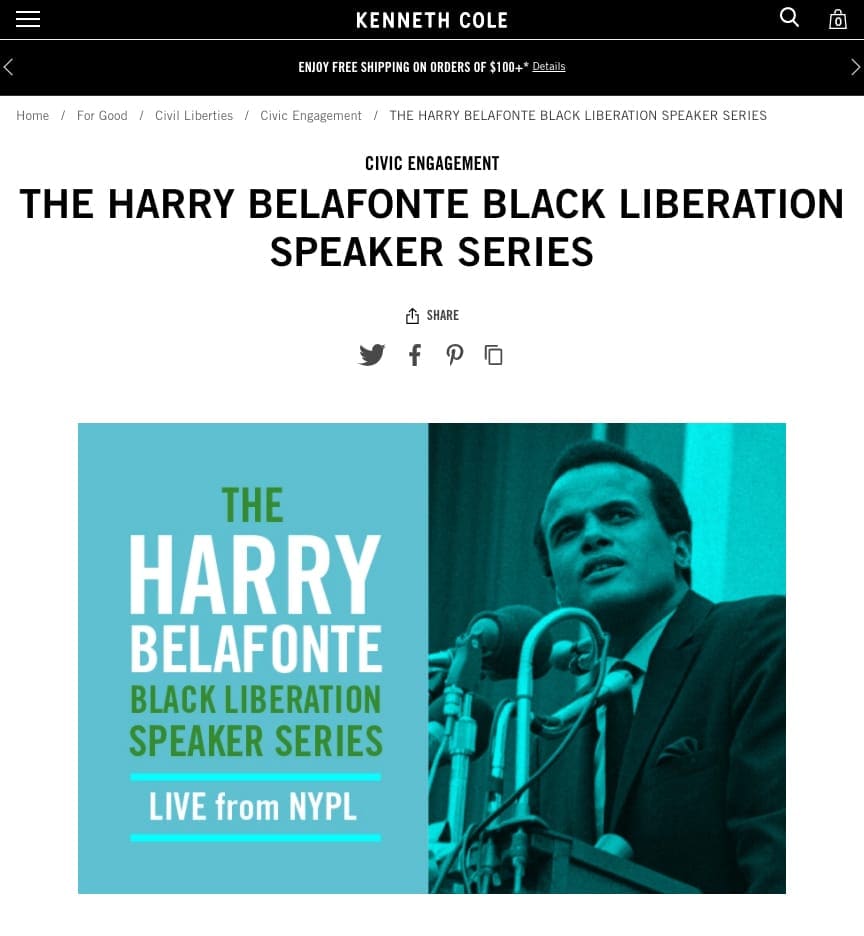
Kenneth Cole now uses cause marketing to invite customers to give with them. This year, they partnered with the New York Public Library to honor the “prolific, progressive, and inspiring life achievements of Harry Belafonte.” The two partners launched the Harry Belafonte Black Liberation Speaker Series in October and are using cause marketing to support it. Currently, the retailer is donating 1% of its online sales to NYPL.
SOLSTICE Sunglasses Promote a Cause with Branded Advertising
SOLSTICE Sunglasses is a luxury sunglass boutique that regularly partners with new and timely causes that fit well with their values. In October, the retailer partnered with the Breast Cancer Research Foundation to help raise money and awareness for the organization.
The foundation promoted the campaign with branded advertising that drew attention to BCRF’s mission. They designated one product to the campaign — a cheap and simple cleaning kit that’s easy to add to any order — and committed $1 for every kit sold. At the end of the month, SOLSTICE matched all the funds they’d raised.
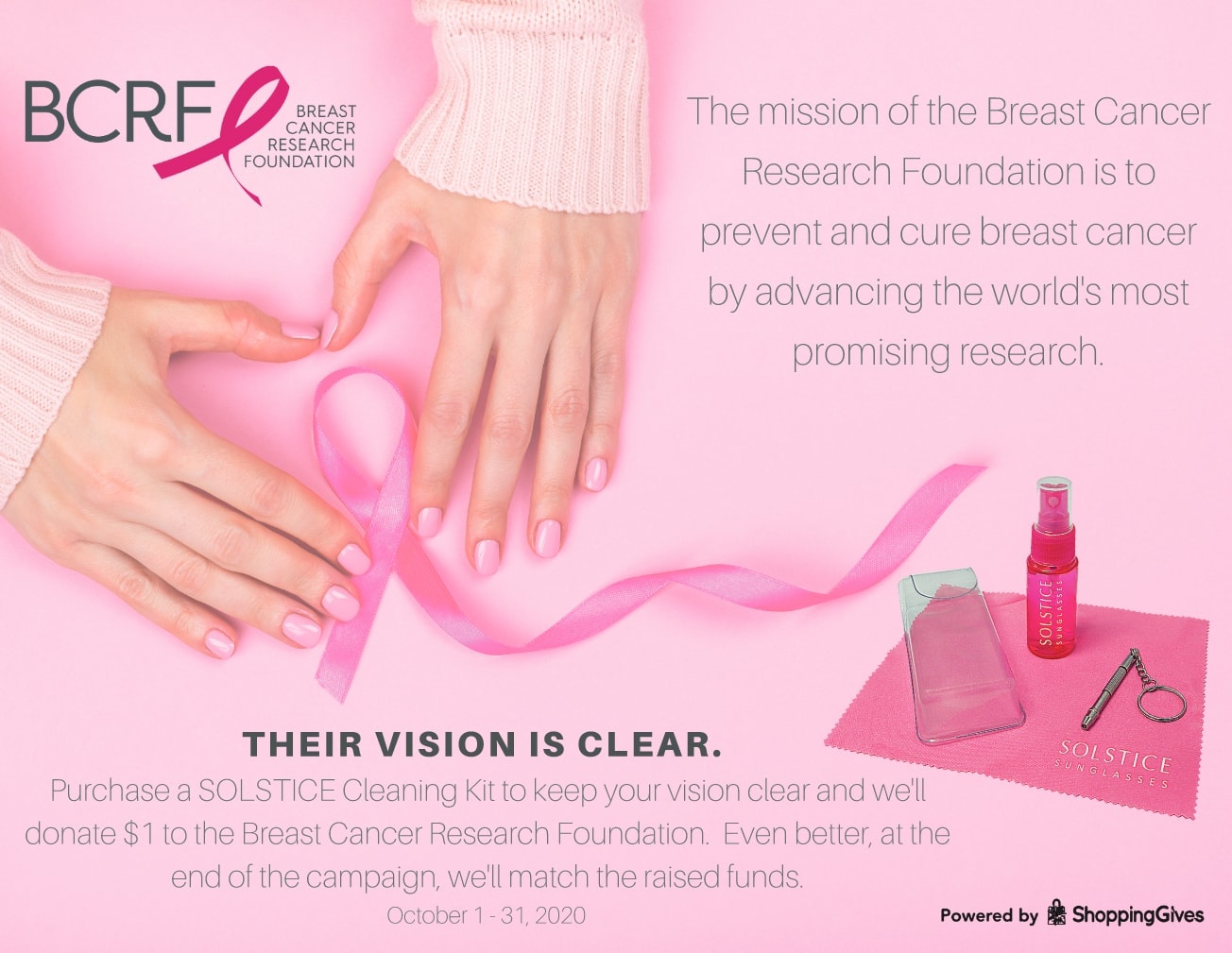
White + Warren Empower their Customers to Choose a Charity
White + Warren’s founder Susan White Morrissey wanted to bring quality cashmere knits to a new generation of women while also empowering them to give back.
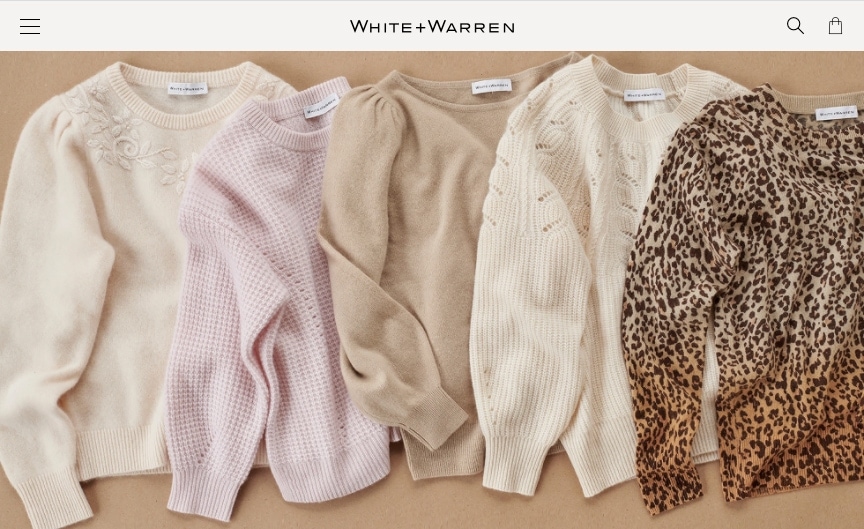
While the company regularly donates to the American Heart Foundation, it also gives its customers the ability to choose an organization to donate to when they check out. Since it started the program, its seen customers who make a donation return to the store 21% faster with an 18% higher lifetime value over other repeat customers.
Kobelli Supercharges their Donations with a Flash Giving Event
The diamond industry is mired by a reputation for abuse and bad business, but fine jewelry retailer Kobelli has vowed to rise above it. The brand is dedicated to bettering their industry by supporting the health and happiness of both their customers and those in their supply chain.
On top of using only lab-grown and conflict-free diamonds, they also use cause marketing to raise money for charities that share their same goals.
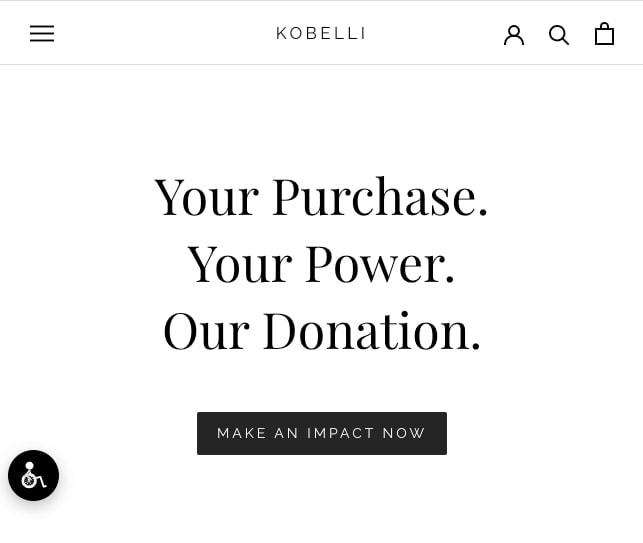
Kobelli donates 1% of all of their sales to charity, giving their customers a choice of six organizations. But in September, they wanted to do more. The company participated in a Flash Giving Event where they donated 10% of all sales from noon until midnight on September 5th.
The flash event, combined with its usual giving, was wildly successful for Kobelli. They now see a 28.9% higher AOV on order with a donation with a 9% higher conversion rate.
Stand Out During the Holiday Shopping Season
For ecommerce retailers, November and December are synonymous with deals and discounts. While everyone races to the bottom, you can stand out by emphasizing a cause instead of a sale.
Your customers already have giving on their minds, so a cause marketing campaign through the holidays can direct that generosity toward helping people and the planet while they’re buying gifts for others. The season gives you an opportunity to make a large impact in a short period of time (while also earning your customers’ trust, respect, and loyalty).
Your cause marketing efforts through the holidays (and anytime, really) are more than a quick win. They’re an investment that brings long-term value by creating more loyal customers. And, since loyal customers shop with you more often and spend more money when they do, that loyalty is worth its weight in gold.
Now’s the perfect time to adopt cause marketing as a strategy for both growing your business and making a positive impact on the world.



